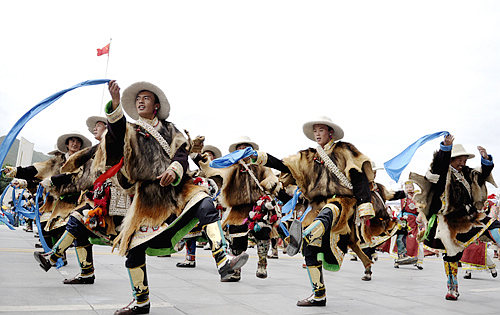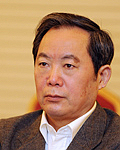|
 |
|
CELEBRATION AT ITS PEAK: Tibetans participate in a parade in Lhasa on July 19, marking the 60th anniversary of Tibet's peaceful liberation (XINHUA) |
On the eve of the 60th anniversary of the peaceful liberation of Tibet, Zhu Weiqun, Executive Vice Minister of the United Front Work Department of the Central Committee of the Communist Party of China, elaborated on the historic importance of the event in an exclusive interview with China Tibet magazine. Excerpts follow:
China Tibet: What is the significance of the peaceful liberation of Tibet?

Zhu Weiqun: The peaceful liberation of Tibet is an important part of the cause of the Chinese people's liberation led by the Communist Party of China (CPC). It is also a great event in the Chinese nation's more than 100 years' struggle to safeguard national unity and sovereignty.
In October 1950, the People's Liberation Army (PLA) liberated Qamdo, thwarting the scheme of a few upper-class Tibetans who attempted to prevent Tibet's liberation. With the support of foreign forces and using the Jinsha River as a natural defense, this small group of Tibetans had attempted to stall the march of the PLA.
After the PLA's victory in the Qamdo Battle, the local government of Tibet headed by the 14th Dalai Lama decided to send a delegation to Beijing for peace talks. After nearly one month of negotiations, on May 23, 1951, the Agreement of the Central People's Government and the Local Government of Tibet on Measures for the Peaceful Liberation of Tibet ("17-Article Agreement" for short) was signed. Tibet was peacefully liberated.
The peaceful liberation of Tibet completed the liberation and unification of China's mainland and was a victory over imperialist forces and a few upper-class Tibetans who wished to split Tibet from China.
Tibet has been a part of China since ancient times. From the Yuan Dynasty (1279-1368), the then Chinese Central Government has exercised direct and effective jurisdiction over Tibet. Western imperialists had coveted the occupation of Tibet from the early 20th century. British imperialists launched two military invasions of Tibet in 1888 and 1904 respectively, and occupied Tibet in 1904. However, they found military means alone were not enough to split Tibet from China, as the local government of Tibet and Tibetan people were loyal to the Chinese Central Government. Therefore, British imperialists started to foster pro-British sentiments among a few upper-class Tibetans. The British encouraged these Tibetans to engage in "pro-independence" activities.
Before the British military invasions of Tibet, there was no word for "independence" in the Tibetan language. So the very concept of "Tibet independence" was actually introduced to the region by Western colonialists.
When the Chinese People's Liberation War (1945-49) was about to succeed, American and British imperialists, as well as a few upper-class Tibetans, realizing that they would likely lose their last chance to achieve "Tibet independence," initiated a series of splittist events including the expulsion of the Han Chinese from Tibet.
These separatist elements sought to turn "Tibet independence" into an established fact before the arrival of the CPC. But their scheme was shattered following the PLA's triumph in the Qamdo Battle, the signing of the 17-Article Agreement and the PLA's peaceful entry into Tibet.
The peaceful liberation of Tibet laid the foundation for the Democratic Reform of Tibet, launched eight years later, which marked the region's transformation from a society of feudal serfdom to one of socialism.
Given the specific conditions that existed in Tibet, the 17-Article Agreement states, "The central authorities will not alter the existing political system in Tibet. The central authorities also will not alter the established status, functions and powers of the Dalai Lama. Officials of various ranks shall hold office as usual." It also says, "In matters related to various reforms in Tibet, there will be no compulsion on the part of the central authorities. The local government of Tibet should carry out reforms on its own accord, and when the people raise demands for reform, they shall be settled by means of consultation with the leading personnel of Tibet."
The Central Government fulfilled its promises, but a few upper-class Tibetans did not want any reforms at all and waged an armed rebellion in 1959. After the rebellion was foiled, the Democratic Reform in Tibet was implemented ahead of schedule. The arrival of CPC cadres and PLA troops following the peaceful liberation allowed Tibetan people to learn about the positive policies adopted by the CPC. The first eight years after the peaceful liberation saw the maturing of social conditions in Tibet. Public support for reforms grew as did the number of capable cadres in the region. The peoples' strong desire for change made the Democratic Reform achievable.
| 